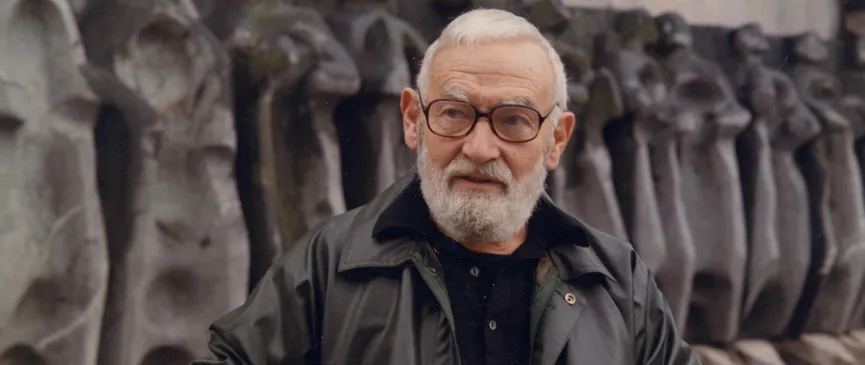Main content
Jorge Oteiza Prince of Asturias Award for the Arts 1988

A controversial sculptor and undeniable figure in contemporary art, Jorge Oteiza (Orio, Guipuzcoa, Spain, 1908 - San Sebastián, Spain, 2003) was a creator of spaces whose work covers the main preoccupations of the avant-garde, showing great interest in archaic and primitive forms and an obsession with reductivist geometry, as is present in movements such as Cubism, Constructivism and Minimalism.
He studied three years of Medicine and three months at an Arts and Crafts College. In 1931, he won the first prize in Sculpture at the Biennial of Guipuzcoan Artists in San Sebastián, the city where he was to give his first individual show in 1934. In his first period, interested in the work and the person of the sculptor Alberto Sánchez and attracted by rationalism into practice in architecture, he took a stance against the conventional art then encouraged in the Basque Country as well as against Surrealism, which was all the rage with many of his fellow artists in Madrid. In 1935, he moved to Latin America, showing in Santiago de Chile and Buenos Aires, and taught in the Argentine National School of Ceramics. In 1942, the Colombian government commissioned him to organise the official teaching of ceramics in Bogota. Two years later, he published his “Letter to the Artists of America”, on new, post-war art, and in 1948 he published his “Report on My Sculpture” in Buenos Aires. During these years, Oteiza had structural problems with a series of figurative sculptures. These were years of a precarious, unstable existence which had greater influence on his intellectual and political formation than on his artistic work. In 1948, he returned to Bilbao and began the most intense period of his life as a sculptor. In the mid-fifties, moreover, a movement of artistic renewal was to arise in Spain, which would give sculpture a previously-unknown importance, to which Oteiza would contribute in an outstanding manner. In 1951, after winning first prize in the national competition to raise a monument to King Felipe IV in San Sebastián, he was given the commission for the sculptures for the new Basilica of Aránzazu, in Guipúzcoa. He won first prize in the IX Triennial of Milan and remained immersed in intense research work which was to be interrupted in 1957 when he was selected for the IV Biennial of Sao Paulo, where he won the International Grand Prix in Sculpture. In 1957, he also set up the Spanish Pavilion at the International Fair in Brussels. In 1959, he declared that his experimental and professional life as a sculptor was over. Minimal formal elements have allowed him, not to delimit spaces, but to create vacuums. He stopped being a sculptor, but did not cease to make sculptures, and carried on intense political, social and cultural work through his poems and studies in aesthetics, linguistics and anthropology. In 1970, he won first prize in the contest of proposals for the urban development in the Plaza de Colón in Madrid. In 2000, Oteiza exhibited one hundred of his sculptural works at the top of Santa Barbara Castle, in Alicante, in the show “Oteiza: Landscapes and Dimensions”. He subsequently showed 88 sculptures and 230 pieces from his “Chalk Laboratory” in San Sebastián. Other shows by Oteiza were held in Logroño, Valladolid and Zaragoza. Among his writings, he has published: “Ensayo de interpretación estética del alma vasca” [Essay on the aesthetic interpretation of the Basque soul] (1963), “Un modelo de hombre para el niño de cada país” [A Model of Man for the Child in Each Country] (1972) and “Existe Dios al Noroeste” [God Exists to the Northeast] (1990).
He was awarded the Gold Medal of Fine Arts in 1985. He received an honorary doctorate from the University of the Basque Country (1998) and was also distinguished with the Gold Medal of Guipuzcoa (19989, the titles of Universal Basque (19979 and Favourite Friend of the Town of Zarautz (199) and the Lan Onari Medal (Merit for Work, 2000). In 2003, the Jorge Oteiza Foundation opened a museum in Alzuza devoted to the work of the artist.
End of main content
